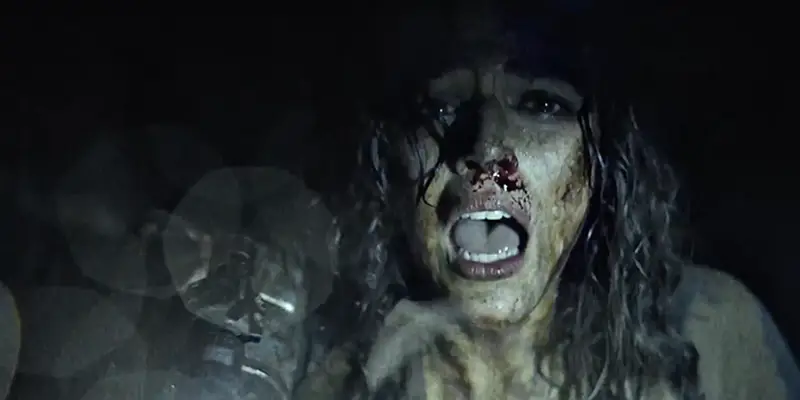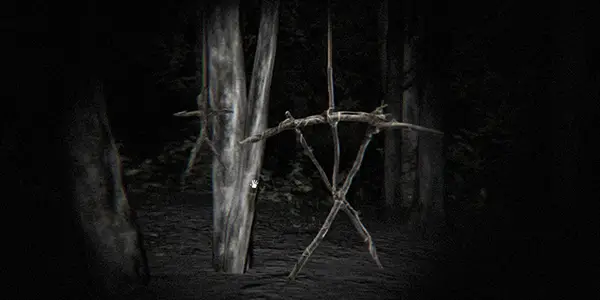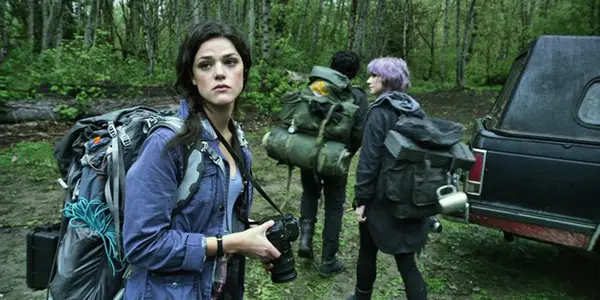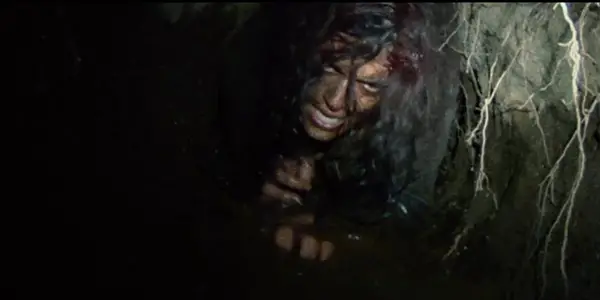BLAIR WITCH: An Unimaginative, Unnecessary Sequel

David is a film aficionado from Colchester, Connecticut. He enjoys…
The idea of the “secret sequel” seems to be a new marketing scheme in horror cinema as of late. Earlier this year, a sequel to the film Cloverfield came out, called 10 Cloverfield Lane, yet nobody knew it was a sequel until a couple months before its premiere. In similar fashion, Blair Witch, the sequel to 1999’s seminal horror The Blair Witch Project, was originally filmed under the fake title “The Woods” so as to hide its true intentions.
The idea seems to be that, when audiences don’t expect a sequel to the original film, the sudden elevated hype that results when the film’s true content is revealed propels fans to see it in droves. Alternately, if the sequel was announced more in advance, it would give people time to question whether or not the film is really worth looking forward to.
Unfortunately, as is the case with the current Blair Witch, even a secret marketing scheme hasn’t contributed to the film’s success, either in terms of box office or overall reception. One has to wonder, after all, whether it justifies its own existence.
The Blair Witch Project
Blair Witch takes place 20 years after the events of the original film. James Donahue (James Allen McCune) is the brother of Heather, who was one of the three that disappeared in the Black Hills Forrest while investigating the Blair Witch legend. Having had obsessed about Heather’s disappearance for years, James gathers together a group of his friends in order to investigate those same woods in the hopes of finding out what happened to his sister.
The original The Blair Witch Project was a landmark film in the horror genre. Found footage had been seen in film before, even as far back as the 1980s, yet never before had it been so prominently used as the central vehicle for the film’s narrative. What distinguished the film even more was the marketing behind it, in which the story was framed around the idea that this was actual unexplained footage found in the woods (going a step beyond that, the three key actors were listed as “missing” immediately after the film’s premiere). Though audiences soon found out that The Blair Witch Project was purely a work of fiction, the original marketing, in addition to its relative ambiguity, still lent a sort of genuineness to the final product.

Blair Witch, however, wastes no time in throwing all of this legitimacy out the window. After a middling first half, the film suddenly elevates from 0-60, throwing everything but the kitchen sink at the audience in a fruitless attempt to scare. What were used effectively as small plot devices in the original film are now escalated beyond reason. For example, instead of a few distant bumping noises in the night, there are full-on screeches, and instead of a few crudely-made figures constructed using sticks that appear outside their tents, there are dozens of figurines of all sizes. Once the characters’ tents started being lifted straight in the air by some unseen force, the film completely lost what little credibility it had left, and almost the entirety of its remainder drags as a result.
While it’s understandable that Blair Witch shouldn’t have been a carbon copy of the original, the film still revealed too much. Think of it in terms of looking at the same photograph from differing perspectives: in The Blair Witch Project, we have a very limited, out-of-focus view of what is actually transpiring, while in Blair Witch, we are seeing a wide-open, perfectly visible perspective of that same portrait composed. By showing too much, the realistic layer that coated the original film has now been ripped away, and the film feels as if it is truly outside the realms of possibility. As a result, it is no longer scary to the same extent.
Modern Found Footage
The found footage genre has changed with the times since its original inception. With the advent of videotaping on cellphones, portable cameras such as GoPros, and the overall ability to have high quality video on a smaller camera, films have utilized these elements to frame their stories. It’s not unexpected, then, that Blair Witch would follow suit at least to some degree. The film is shot through a mixture of basically every modern technology: there are a few handheld cameras used in addition to cellphones, tiny cameras that attach to each person’s head, a GoPro, and even a cellphone attached to a drone that can film the skyline from up above.
The issue with such overuse of technology, though, is that it detracts from the found footage element. When characters speak, the nearest camera to their face focuses in, and, likewise, then switches back to the perspective of the person responding. If all the characters are standing in a circle, there is seemingly no angle that the many cameras can’t capture. Essentially, the film feels like a conventional horror film, albeit with excessively shaky cameras, since it is very obvious that somebody edited the footage from all of them together into a coherent narrative.

Furthermore, since these eight or so cameras (by my count) were supposedly found in the middle of the woods, are we supposed to believe, since everybody ended up in different places, that the Blair Witch conveniently gathered all the footage together for the subsequent finder’s convenience? Perhaps she even labeled them in sequential order so as to make the editing process more manageable? How thoughtful of her to have gone through such trouble.
Since the original The Blair Witch Project basically molded the found footage subgenre at its beginnings, it’s ironic that the filmmakers of Blair Witch did everything they could to make it seem as far away from it as possible.
Fears and Scare Tactics
Though with much at fault, Blair Witch at times did manage to genuinely unsettle me. Perhaps this is due to the fact that, as mentioned, the film throws almost every horror trope at the audience in the hopes that something will stick. There are jump scares aplenty, an overuse of the heavy breathing and face closeup element that was used in the first film (think of the “I am so scared” scene), and some occasional body horror. Some of this works; much of it doesn’t.

Perhaps the most unnerving sequence of the film is a long, claustrophobic tunnel sequence, which admittedly had me white-knuckled and grasping the seat next to me for its entire length. The issue with the scares in Blair Witch overall, though, are that, as flustered as you might have felt in the theater, the fears don’t take too long to dissipate.
The original Blair Witch Project works because it buries under your skin – its ambiguity makes you question the reality of what is transpiring on screen. Watching it again recently, one line in particular stuck out to me, in which one character says to Heather that he understood why she was always filming everything around her. Viewing the world through a video camera, he states, is a sort of “filtered reality, like you can pretend everything is not quite the way it is.”
In Blair Witch, by contrast, what you see is what you get. That, to me, is a far less scary concept.
Direction
Blair Witch is directed by Adam Wingard, who in the past helmed the fantastic The Guest and You’re Next. Both of these films contain similar directorial trademarks – they each focus on a subversion of initial expectations such as the charismatic, maybe not-so-normal new friend in The Guest, or the seemingly helpless female survivor in You’re Next. Each of these films also feature a prominent soundtrack which help to drive their narratives.
Here, though, in part due to a rudimentary script, Wingard is given little to work with. The characters are not only poorly written and underdeveloped, but their demises are completely predictable. In addition, due to the film being found footage, there is obviously no way for sound to be utilized in the way that Wingard effectively has in the past. In short, it is an unfortunate addition to an otherwise hopeful horror resume.
Conclusion
Blair Witch ultimately falls victim to the flaw that many sequels come to: in an attempt to escalate on the scares of the original, it presents an overly lavish, elaborated plot that panders to modern audiences who tend to prefer the scare-a-minute horror films over those more drawn out and psychological in nature.
What the filmmakers failed to fully realize, though, is that the original film succeeded precisely because of its subtlety. By showing too much in an unfocused manner, the grounded reality of the Blair Witch legend is peeled back to reveal the very obvious paranormal story at its heart, making the sequel a dull and listless venture to sit through.
The “secret sequel” may be a good marketing plan for the promotion of horror films, and might even be more of a success with films in the future. Regardless of the marketing, however, the films themselves have to feel as if they are worth that now overly-heightened immediate hype. Blair Witch, unfortunately, fails to deliver.
What are your thoughts about Blair Witch?
Blair Witch is currently playing in U.S. and U.K. theaters. Find international release dates here.
Does content like this matter to you?
Become a Member and support film journalism. Unlock access to all of Film Inquiry`s great articles. Join a community of like-minded readers who are passionate about cinema - get access to our private members Network, give back to independent filmmakers, and more.
David is a film aficionado from Colchester, Connecticut. He enjoys writing, reading, analyzing, and of course, watching movies. His favorite genres are westerns, crime dramas, horror, and sci-fis. He also enjoys binge-watching TV shows on Netflix.












